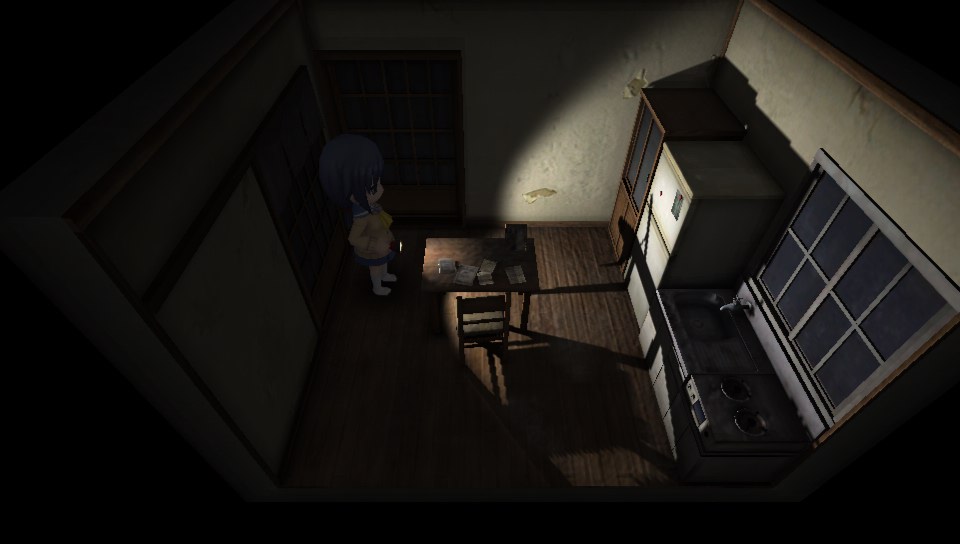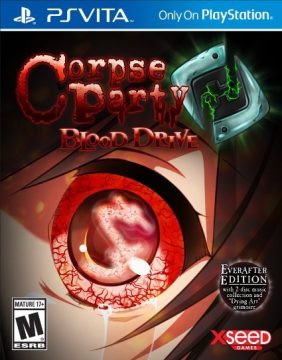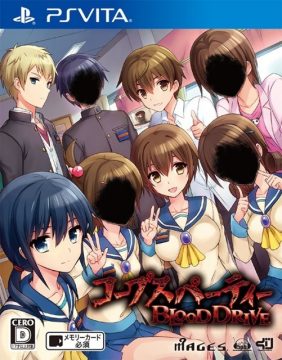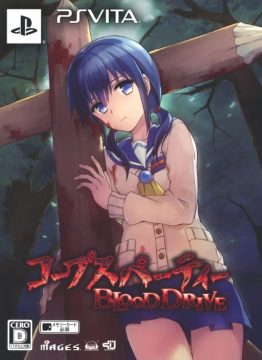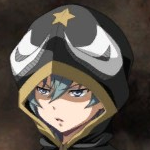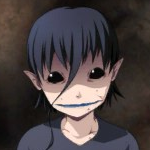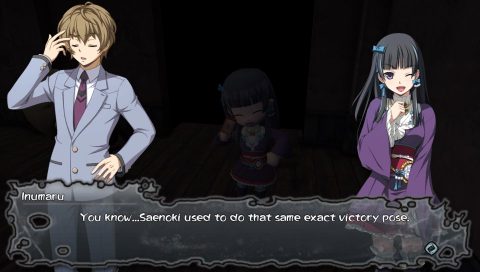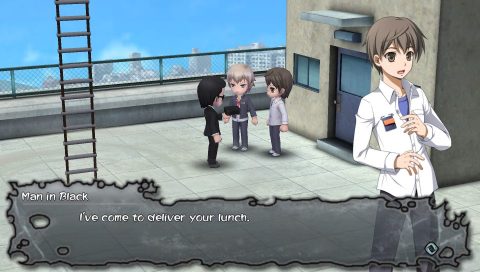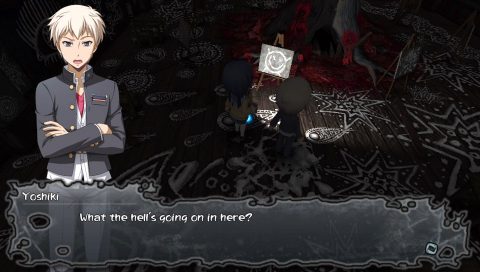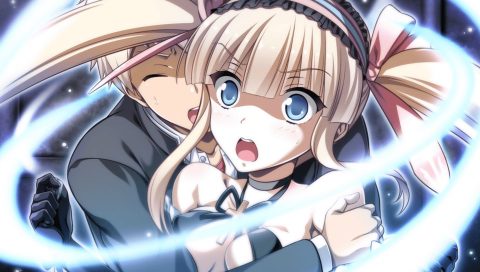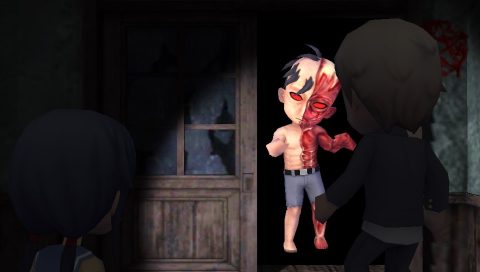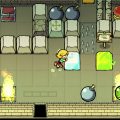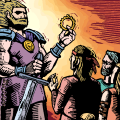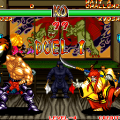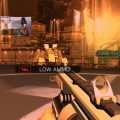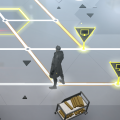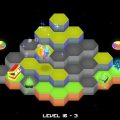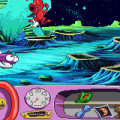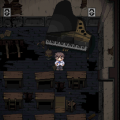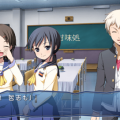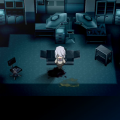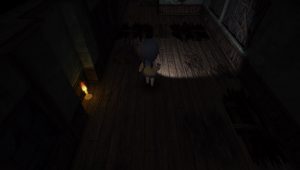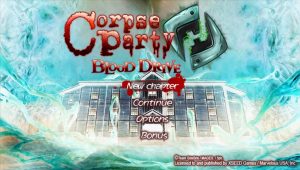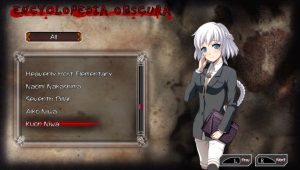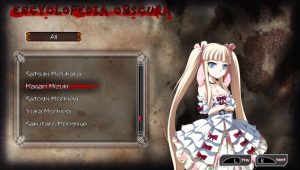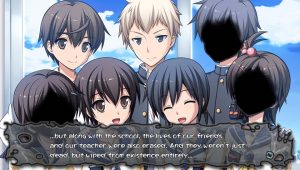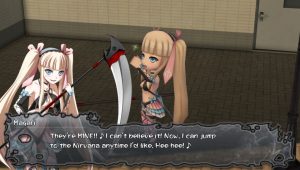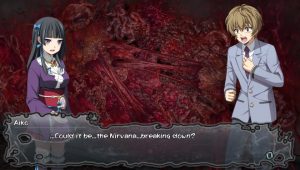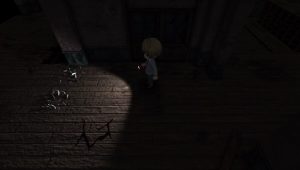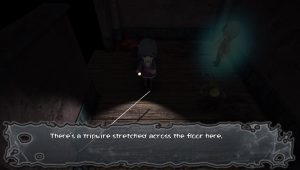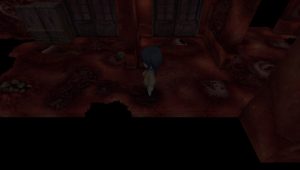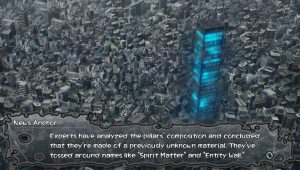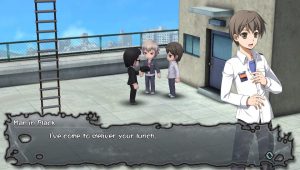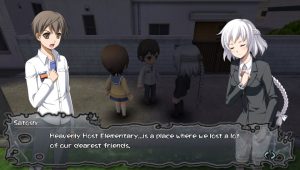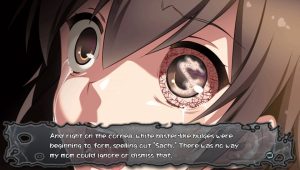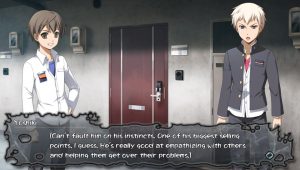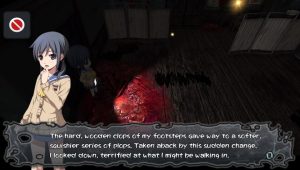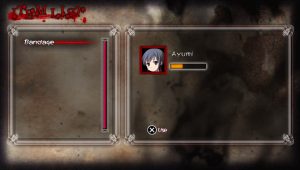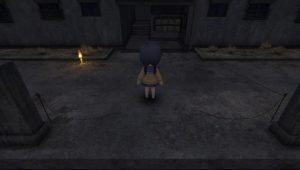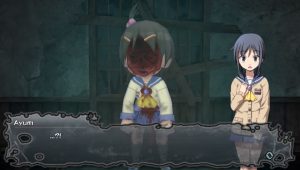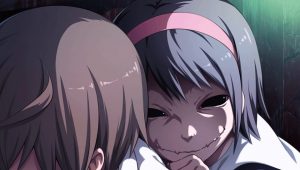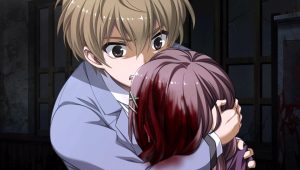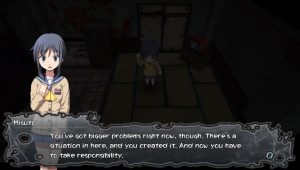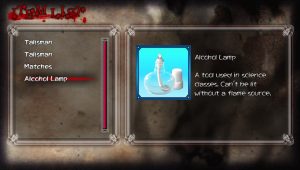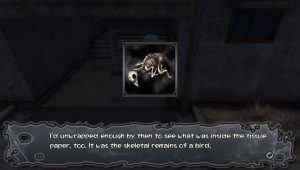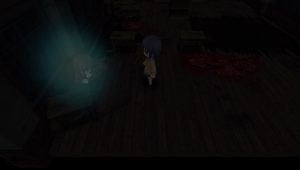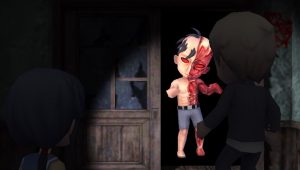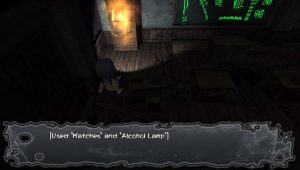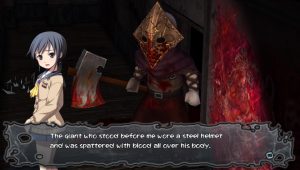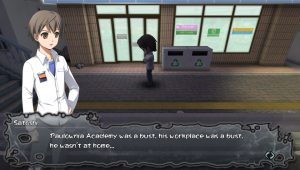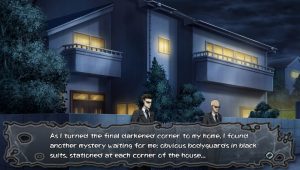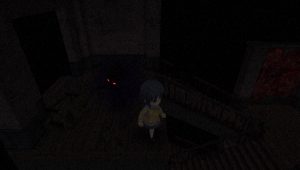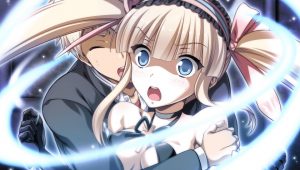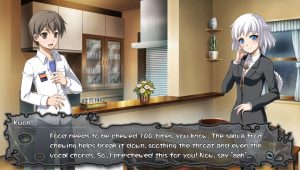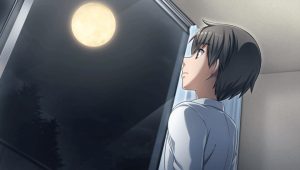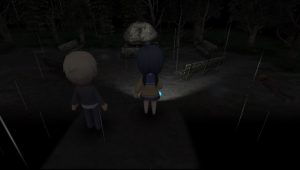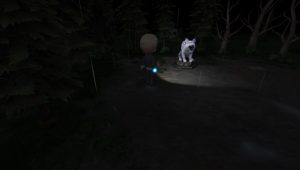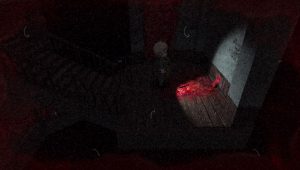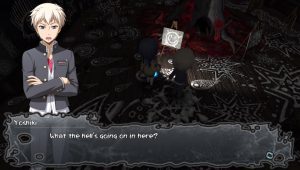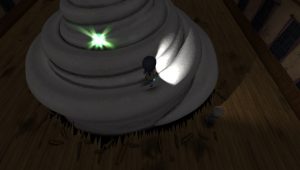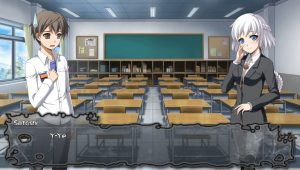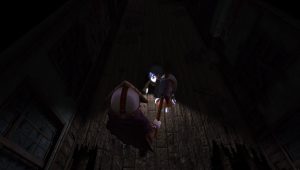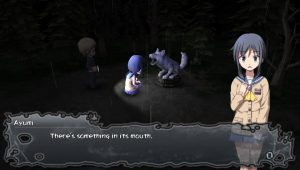Corpse Party: Blood Drive begins several months after Blood Covered, and finds Ayumi Shinozaki in a guilt spiral over initiating the plot of Blood Covered and final chapter of Book of Shadows. Unfortunately, she’s guilty enough to be malleable, and there are two rival clans of witches (yes, witches!) ready to make use of her connection to the Book of Shadows from the previous game. Meanwhile, Heavenly Host is collapsing, even mutating into a new form the witches call “the Nirvana”. If Ayumi can spin things the way she wants, she might even undo the deaths from the original game, but if things go wrong, they’ll go worse than she could have ever imagined.
Kuon Niwa
Aiko’s unbelievably-talented older sister, Kuon is not only head of an occult megacorporation, but is the cast’s replacement English teacher. Her perfection is initially used for comedy, but turns to drama later on. Some of her secrets are so preposterous, they arguably threaten the story’s credibility, but there’s heart in there too.
Magari Mizuki
One of two magic users the begin to hound Ayumi, Magari is the ostentatious heir to an already less-than-covert cult called the Martuba. While the doomsaying Martuba are (somewhat inadvertently) responsible for a lot of the hassle you go through in the game, Magari is not so suicidal, and is willing to cooperate if the situation demands.
Misuto Kiriya
Sole survivor of a benevolent clan of priests, Misuto is now pure evil, and only Ayumi is desperate enough to overlook that he’s gone full supervillain. Claims to have a connection to Ayumi’s sister, who appeared briefly in previous entries.
Sachi Shinozaki
Sachiko’s “vanishing twin“, who became a ghost after a particularly improbable series of events. While not the game’s final antagonist, she’s the retconned explanation for why Heavenly Host persisted after the True End of Blood Covered, and has to be dealt with before the plot can wrap up for good.
Blood Drive is another RPG-Adventure game, and while it closely resembles Dead Patient, it swaps the cell shading for semi-realistic textures. The game was created in Unity rather than Grindhouse’s proprietary Kenix Engine, so had none of Dead Patient’s launch problems. Unfortunately, the game is prone to mild lag, which occurs whenever it tries to load audio clips in busy areas, like the school’s hallways. This isn’t likely to hurt the player, but is a nuisance. The pool sequence in Chapter 4 is about the only time the game actually slows to a crawl.
Like Dead Patient, Blood Drive saw fit to supplement the puzzle-solving with action threats, but its approach is distinct. Numerous tiles in the school are now trapped, with things like glass shards or weak floors, and will cause HP damage if you cross them. The biggest trouble with traps is that they’re hard to see in the dark. Tripwire traps are the worst, since they’re barely visible, cause high damage, and must be manually disarmed. The player has access to a light source at all times, but this light will eventually die, forcing the player to replace its battery. Because the school isn’t all that dark, it’s tempting to move around without a light, but deathtraps will discourage this quickly. Unfortunately, deathtraps aren’t moved between chapters (except for the tripwires), so their impact on challenge gets less and less as the game moves on.
The whole process of collecting batteries must have been frustrating for some players, because patched versions of the game (including all international releases) feature an “Endless Battery Mode” that the player can use toggle on and off by pressing Select, which works without consequences.
In addition to the deathtraps, the game also has minor enemies, all of them chasers. The run button from Dead Patient returns, but is now attached to an invisible stamina meter that will force you to stop for a few seconds if you run out, almost certainly getting you killed in a pursuit. There are two major strains of enemies in Blood Drive. “Phantoms” will pursue the player indefinitely, even past loading zones. This forces the player to hide in a cupboard, at which point the player will be given a special meter to help them know how far away the enemy is from their hiding place. Unlike the Dead Patient enemies, Phantoms are smart enough to spot you entering a cupboard, and will pull you out and pummel you. The second enemy type are Pyramid Head-looking “golems”, which will not pursue through loading zones. The golem’s limited range, plus their embarrassing attack speed, makes it hard to take them seriously.
Players can defend themselves against enemy attacks with one-use Talisman items, which trigger the moment the player is hit by an enemy attack. Talismans will destroy Phantoms, but will simply stun golems and “boss” enemies for a short period. Once you run out of Talismans, you’re screwed. There is no “second wind” after escaping damage like in Dead Patient. Since enemies can catch you if you try to enter a cupboard within their line of sight, it’s easy to become trapped in an inescapable situation, with no Talismans, stamina, or hope. A player might be forced to restart a chapter if things go especially wrong, so it might be worth cheating by saving and then loading the game, which returns enemies to their spawn points. All-in-all, the minor enemy system is more frustrating than enjoyable, and may be the worst element in the game.
The bloody overlay from Dead Patient returns to show your damage, but it doesn’t work in the same fashion. Instead of starting transparent and becoming opaque as you take damage, it appears at full opacity when you go below 50%, obstructing the view in an instant! The player can also take darkening “damage” from special traps. This produces a static overlay over the entire screen. Naturally, you can get both at the same time, blocking almost the entire screen! The player can ration out damage between party members by changing the lead character with the touch of a button, but certain deathtraps will damage all characters in the party. HP damage can be restored with items, or by simply visiting a save candle. Darkening, meanwhile, can only be healed at single-use statuettes.
While the action gameplay has seen a lot of work, Blood Drive’s Adventure-style gameplay has suffered. None of the Adventure improvements from Dead Patient appear in Blood Drive. Blood Drive does have one improvement of its own, but it’s dubious: instead of automatically using the correct item when you discover an item puzzle like in Blood Covered (and instead of forcing you to equip items like in Dead Patient), the game now presents you with your inventory, and the player is forced to select the correct item manually. It’s only slightly more challenging than the old formula (and far less than Dead Patient’s equip system), but it’s better than nothing. Unfortunately, Blood Drive is short on puzzles. Most of the game involves little more than moving from story checkpoint to checkpoint, dodging chasers and deathtraps.
The devs also made the mistake of leaving nearly every door in the school unlocked. In previous games, doors were sealed when they weren’t relevant to the plot, and rooms changed their contents and text descriptions from time to time. Blood Drive does neither even though most rooms hide little more than a bandage or a battery, so all this empty spaces adds nothing but dead playtime.
Another downgrade from previous games is that there are few Wrong Ends with unique CGs, even though previous game under 5pb gave nearly every death a CG. Several Wrong Ends don’t even have text, relying on (often abbreviated) chibi animations to somehow horrify the player. Mario has suffered more gruesome deaths – sometimes even on-camera! Even when there is text, Wrong Ends are much more abrupt than in the past.
Nametags return, and are now sorted by chapter instead of by school, which makes finding them far easier than in the past. They also display their whole contents when found, getting rid of the menu-digging present in previous games.
Unlike Blood Covered and Dead Patient, Blood Drive has most of the Visual Novel creature comforts mentioned throughout these articles, namely a backlog, a skip button, and the ability to hide the text box, although there is no “auto” button for some reason. Unfortunately, the skip button doesn’t affect animations, which are just as long and slow as they were in Dead Patient. As mentioned above, Blood Drive uses a save point system instead of the VN save-anywhere seen in the past few games. The game doesn’t even have a temporary Save & Quit option like the portable versions of Blood Covered, which is rough, since its VN sequences can drag on for half an hour or more, and the player has to ride out the whole thing out before they can save. The player might not even be near a candle when the sequence ends!
Blood Drive features eight Extra Chapters, all of them Visual Novel-style with no gameplay, save a single, inconsequential branching path. Depending on reading speed, these chapters range from over an hour to one a belly-flop chapter which clocks in under a minute. Some of these Extra Chapters are more important than those we’ve seen in the past, giving crucial background information or serving as the last word from otherwise deceased characters, but there are still a few stinkers.
With all its gameplay and narrative changes, Blood Drive just doesn’t feel like it belongs to the same series as Blood Covered and Book of Shadows. Most of the familiar antagonists are gone, and the focus from individualized, disturbing horror from the originals seems to have been tossed aside in favor of a macabre-fantasy knot, which simultaneously tries to plug outrageous, anime-style magic users and the historical tragedy of the European witch hunts into the series’ established, small-scale backstory. It didn’t have to be this way. At one point, the game comes up with the brilliant idea of embodying Ayumi’s guilt – one of the plot’s central elements – by forcing her to flee from one of her dead friends. This unsettling and thematic idea is tossed in the trash the moment it’s past, and is replaced with the generic Phantoms and golems that mean nothing to the player and characters. That decision feels like it embodies a lot of the problems with the game at large.
The game also has a different approach to humor than Blood Covered and Book of Shadows, being more in line with Hysteric Birthday. This isn’t a negative, but it is… strange. For example, Blood Drive features “horror” setpiece made of soft-served ice cream, and Kuon’s comedy subplot runs for far longer than you’d expect.
Lastly, it’s got to be said: pulling Sachiko’s vanished twin’s ghost out of a hat and then making her King of the Castle feels like the kind of creative decision you’d see in a direct-to-DVD horror sequel.
Blood Drive may be the weakest game in the series, but fans will still want to give it a play. For all Blood Drive does wrong, characterization is mostly intact, and the game finally brings the story to a close, tone and circumstances be damned. It’s more than worth the price of admission just to see things wrap up for these beloved characters, at least until Dead Patient forces them back into the field.
Blood Drive was originally released on the Playstation Vita in Japan in 2014. It saw international release in 2015, and was the first international Corpse Party game to be available in both physical and digital formats at launch. The game is technically PlayStation TV compatible, although it does occasionally crash on the system. Blood Drive also saw simultaneous release on both iOS and Android, and in both Japan and North America, in February 2017, and later in Europe. A PC release is also due in the near future, though the release date is unknown.
Links
